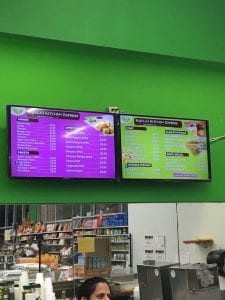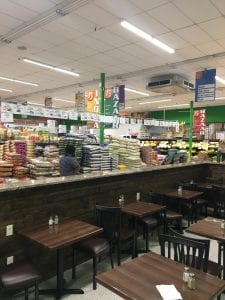After many Frank Ocean songs and red lights on Skillman St., “the Field Trip Crew” -Aarthi Parvathaneni, Sophi Farid, and myself- finally made it to the India Bazaar in Richardson, Tx. The class was already in line at the Bazaar’s café: Rajula’s Kitchen Express. The café’s notion of celerity, we soon found out, is slightly misleading (however, that is to be expected when only three cooks are asked to prepare around 20 meal orders).
Before I ordered my dinner, I talked with classmates that are more privy to Indian food, and also considered Arijit Sen’s chapter, “From Curry Mahals to Chaat Cafés”. I decided to order two Samosas, the Aloo Tikki Chaat, and a bottle of water. My initial bill was only $9, but due to my unaccustomed taste buds and the Chaat’s spiciness, I later bought two more water bottles. I had never tasted anything even remotely similar to the Aloo Tikki Chaat. All I had before I ordered were people’s suggestions, and Arijit Sen’s useless description: “a crunchy mix of stuffed fillings and topped with a tangy sauce” (A. Sen, 204). If I were asked to describe the dish, I would say that chaat is sour, sweet, and spicy -simultaneously.
In addition to being tasty meals, the chaat and samosa have interesting roles in Indian culture throughout the subcontinent’s history. For example, the samosa –“a triangular pastry filled with minced meat and nuts”- was a popular dish in the Delhi Sultanate (Sen, 155). During the 13th century, Islam heavily influenced the Delhi Sultanate and its culture because the dynasty’s sultans and ruling class were primarily Muslims. In fact, 10th and 11th century Arab cookbooks use the word “samusak” to refer to the samosa pastries (Sen, 155). The samosas, however, were only my appetizer; the chaat was my main dish. As the menu shows, there are different types of chaat available based on personal preferences. Originally a ”roadside snack food in North India,” I think that the chaat’s equivalent in Texan cuisine is the taco. For many Indians, the chaat is intimately connected with its communal and social aspects: Arijit Sen notes that “going for a chaat ‘is a social act with the same casual sociability as going for a beer’” (A. Sen, 205).
Arijit Sen observes that some “outsiders” can sometimes “feel unwelcome because of their unfamiliarity with the ambiance of [Indian] spaces” (A. Sen, 198). While I definitely belong in the “outsider” category insofar as Indian culture, to me the Bazaar’s atmosphere was foreign, but equally inclusive and relaxed. I enjoyed my food, and the experience.
Works Cited
Sen, Arijit. “From Curry Mahals to Chaat Cafes.” Berkeley: U of California, 2015. 196-218. Print.
Sen, Colleen Taylor. Feasts and Fasts: A History of Food in India. London: Reaktion, 2015. Print.




